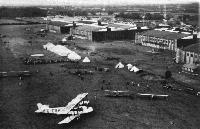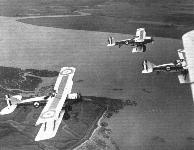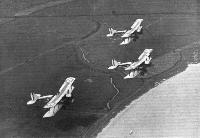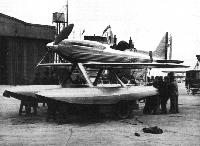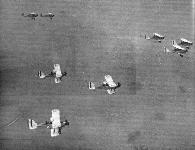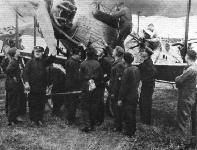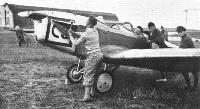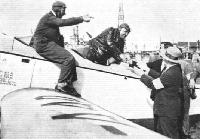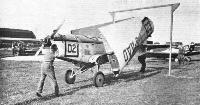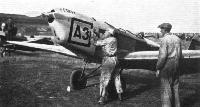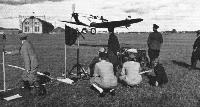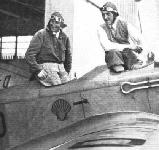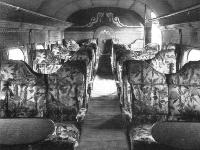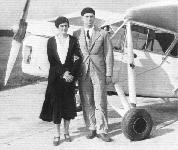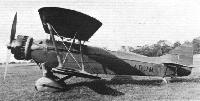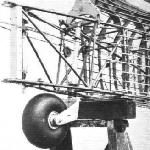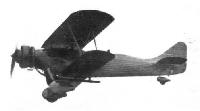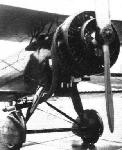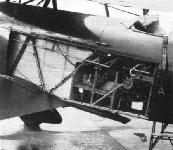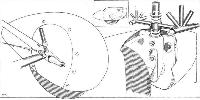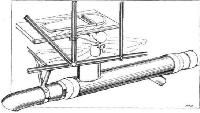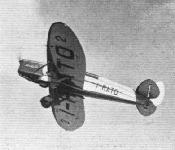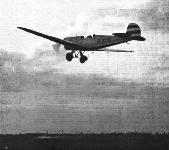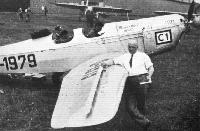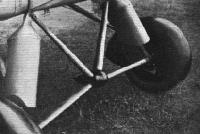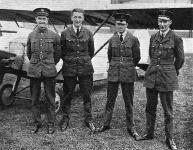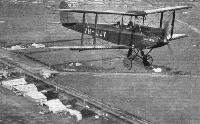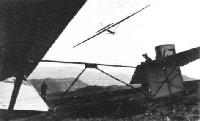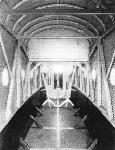Фотографии
-
The Northrop Alpha is an all-metal aircraft carrying 1,822 lb. useful load. Its cruising speed is 140 m.p.h. with a radius of 700 miles and 116 gall, of fuel. The engine is a Pratt and Whitney Wasp of 420 h.p. With a wing area of 295 sq. ft. the wing loading is 15 25 lb. h.p. and the power loading 10 7 lb./h.p. It is probably one of the most efficient American transport aircraft and has accommodation for 7 passengers.
Самолёты на фотографии: Northrop Alpha - США - 1930
-
Регистрационный номер: D-378, PH-AED, PK-AED AN INTERNATIONAL JUNCTION: Schiphol, the airport of Amsterdam, is called at by Fokker machines of many international airlines. The photograph shows in the foreground a K.L.M. Fokker F.VIII, next to it a Fokker F.III belonging to the German Luft Hansa, and a Fokker F.VIIa of the Danske Luftfartselskab. In the second row, from left to right; Fokker F.VIIb-3m Swissair, F.VIIb-3m Sabena (Belgium), F.VIIb-3m Ceskoslovenska Letecka Spolecnost (Czechoslovakia). In the background another Lufthansa F.III.
Самолёты на фотографии: Fokker F.III - Нидерланды - 1921Fokker F.VII / C-2 / F.XIV - Нидерланды - 1924Fokker F.VIII - Нидерланды - 1927
-
Регистрационный номер: G-EBBI An Aerial view of Baldonnel Aerodrome. The H.P. W.10 in the foreground was doing joy-riding throughout the meeting piloted by Capt. E. B. Fielden.
Самолёты на фотографии: Handley Page H.P.18 (W.8) / H.P.30 (W.10) - Великобритания - 1919
-
WHAT HAS THE ISIS COME TO? The formation flown by members of the O.U.A.S. over the Thames near Sheppey. The instructor can be seen in the leading machine, but the pilots are all undergraduates.
Самолёты на фотографии: Bristol F.2A/F.2B Fighter - Великобритания - 1916
-
OXFORD IN THE AIR: Formation flying by members of the O.U.A.S. An instructor is in the spare seat of the leading machine but the pilots are all undergraduates.
Самолёты на фотографии: Bristol F.2A/F.2B Fighter - Великобритания - 1916
-
THE DARK BLUE AEROPLANES: Four "Bristol Fighters" and eight "Lynx-Avros" at Eastchurch. A dark blue line is painted on each fuselage.
Самолёты на фотографии: Avro Avro 504N - Великобритания - 1920Bristol F.2A/F.2B Fighter - Великобритания - 1916
-
Регистрационный номер: S1595 Успех S.6B на гонках Шнейдера. 13 сентября 1931г.: С целью в третий раз выиграть для Британии Кубок Шнейдера в гонках принял участие на S.6B флайт-лейтенант Дж. Н. Бутман. Он пролетел маршрут длиной 350 км со средней скоростью 547,305 км/ч. S.6B, улучшенный S.6, был оснащен мотором Rolls-Royce "R" мощностью 2300 л.с. Бутман в 7,5 раз превысил среднюю скорость победителя первых гонок на Кубок Шнейдера, состоявшихся 18 годами ранее.
A VICKERS-SUPERMARINE ROLLS-ROYCE S.6.B.: This seaplane, S1595, is the first of the two new racers to be delivered to the High-Speed Flight at Calshot. other, S1596, was delivered on August 11. The Rolls-Royce "R" engine is housed in the Vickers-Supermarine S.6 B with a minimum loss of space, and in an extremely small frontal area. It was on this actual machine, but with a different Fairey metal airscrew, that Flt.-Lt. Stainforth established a new world's speed record of 408-8 m.p.h.Самолёты на фотографии: Supermarine S.5 / S.6 - Великобритания - 1927
-
Регистрационный номер: S1596 Создатель S.6B Реджинальд Митчелл позже спроектировал истребитель Spitfire. Тем временем, разработавшая двигатель "R" группа во главе с сэром Генри Ройсом создала для него мотор Merlin.
The second Vickers Supermarine Rolls Royce S.6.B. - Marked S1596.Самолёты на фотографии: Supermarine S.5 / S.6 - Великобритания - 1927
-
The Squadron in formation near Tangmere.
Самолёты на фотографии: Westland Wapiti - Великобритания - 1927
-
GETTING READY FOR A FLIGHT: The men of No. 600 B.S. are tremendously keen.
Самолёты на фотографии: Westland Wapiti - Великобритания - 1927
-
The Officers of No. 600 (City of London) (Bomber) Squadron in Camp at Tangmere.
Самолёты на фотографии: Westland Wapiti - Великобритания - 1927
-
The Airmen of No. 600 (City of London) (Bomber) Squadron: All but about a dozen are City clerks, and they maintain their "Wapitis" and "Jupiters" in fine condition.
Самолёты на фотографии: Westland Wapiti - Великобритания - 1927
-
THE WINNER: The Klemm L.26 Va (Argus As 8) which Lieutenant Dinort flew to victory.
Самолёты на фотографии: Klemm L.25 - L.28 Swallow - Германия - 1927
-
ENGINE-STARTING TEST: Propeller-swinging was not permitted. Wolf Hirth's Hirth engine being started.
Самолёты на фотографии: Klemm L.25 - L.28 Swallow - Германия - 1927
-
SECOND PRIZE: Wolf Hirth secured second place on the Klemm fitted with the engine designed by his brother Hellmuth Hirth, who is seen standing on the left.
Самолёты на фотографии: Klemm L.25 - L.28 Swallow - Германия - 1927
-
Some of the Competitors at Staaken Aerodrome before the Start.
Самолёты на фотографии: Klemm L.25 - L.28 Swallow - Германия - 1927
-
Регистрационный номер: TS-AAD [2] THIRD MAN HOME AGAIN: Adolph Kneip greeted on his arrival at Tempelhof upon his getting third place in the "Deutschlandflug."
Самолёты на фотографии: Klemm L.25 - L.28 Swallow - Германия - 1927
-
Регистрационный номер: TS-AAD [2] THE FOLDING AND "DOOR-WHEELING" TEST: Kneip's machine going through the "gate."
Самолёты на фотографии: Klemm L.25 - L.28 Swallow - Германия - 1927
-
FIRST IN THE TECHNICAL TESTS: Reinhold Poss (Klemm-Argus) secured the highest number of points in the technical tests.
Самолёты на фотографии: Klemm L.25 - L.28 Swallow - Германия - 1927
-
IN THE LANDING TEST: This year competitors did not have to land over an obstacle.
Самолёты на фотографии: Klemm L.25 - L.28 Swallow - Германия - 1927
-
THE WINNER: Oskar Dinort and his passenger Freiherr von Houwald.
Самолёты на фотографии: Klemm L.25 - L.28 Swallow - Германия - 1927
-
THE NEW HANDLEY PAGE 42, WESTERN MODEL: An interior view of the aft cabin looking aft. This machine accommodates 38 passengers.
Самолёты на фотографии: Handley Page H.P.42 / H.P.45 - Великобритания - 1930
-
Mr. T. H. Naylor (Liverpool) and his "Puss Moth" at Hooton.
Самолёты на фотографии: De Havilland Puss Moth / D.H.80 - Великобритания - 1929
-
ROYAL AVIATORS: Princess Ileana and her husband, the Archduke Anton of Hapsburg, standing beside their "Puss Moth," a wedding gift from King Carol.
Самолёты на фотографии: De Havilland Puss Moth / D.H.80 - Великобритания - 1929
-
Регистрационный номер: G-ABIX THE FASTEST IN THE RACE: Mr. Thornton, designer, and Flt. Lt. Wincott (R.) in front of the Arrow Active before the race.
Самолёты на фотографии: Arrow Active - Великобритания - 1931
-
Miss W. Brown's "Sports Avian" fills up with National Benzole at Hooton.
Самолёты на фотографии: Avro Avian / Type 594/616 - Великобритания - 1926
-
Регистрационный номер: G-ABJM [10] This side view shows that the robustness common to all Avro aircraft has not been sacrificed although exceptionally clean lines have been obtained.
Самолёты на фотографии: Avro Mailplane / Type 627 - Великобритания - 1931
-
Регистрационный номер: G-ABJM [10] The clean lines and low head resistance, in spite of the large radial engine fitted to the Avro "627" are well depicted in the photographs.
Самолёты на фотографии: Avro Mailplane / Type 627 - Великобритания - 1931
-
Регистрационный номер: G-ABJM [10] THE UNDERCARRIAGE: Simplicity with efficiency has obviously been maintained throughout in constructing the Avro 627, as the details of the undercarriage will show.
Самолёты на фотографии: Avro Mailplane / Type 627 - Великобритания - 1931
-
Регистрационный номер: G-ABJM [10] THE TAIL WHEEL: The construction of the tail wheel springing can be seen here as well as the tail-plane incidence gear.
Самолёты на фотографии: Avro Mailplane / Type 627 - Великобритания - 1931
-
Регистрационный номер: G-ABJM [10] WING DETAILS: The strip steel spars and duralumin ribs exemplify Avro workmanship.
Самолёты на фотографии: Avro Mailplane / Type 627 - Великобритания - 1931
-
Регистрационный номер: G-ABJM [10] Самолёты на фотографии: Avro Mailplane / Type 627 - Великобритания - 1931
-
Регистрационный номер: G-ABJM [10] THE ENGINE MOUNTING: Simplicity with efficiency has obviously been maintained throughout in constructing the Avro 627, as the details of the engine mounting will show.
Самолёты на фотографии: Avro Mailplane / Type 627 - Великобритания - 1931
-
Регистрационный номер: G-ABJM [10] The attention which has been paid to the reduction of drag can be seen by the double form of Townend Ring and the "spats" over the wheels.
Самолёты на фотографии: Avro Mailplane / Type 627 - Великобритания - 1931
-
Регистрационный номер: G-ABJM [10] The side panels of the fuselage may be quickly and easily detached to expose all pipes and control rods for adjustment and maintenance.
Самолёты на фотографии: Avro Mailplane / Type 627 - Великобритания - 1931
-
Регистрационный номер: G-ABJM [10] Our photograph shows the mail compartment with the lid open. This lid folds again twice and so does not impede loading up of the compartment.
Самолёты на фотографии: Avro Mailplane / Type 627 - Великобритания - 1931
-
WHEEL DETAILS: On the left the sketch shows the method of attaching the streamline fairing over the landing wheels, while on the right the tail wheel and its springing is shown. The hollow steel fork carrying the wheel (see small sketch) is shown cut through in order that the method of attaching the fairing to a transverse plate may be understood.
Самолёты на фотографии: Avro Mailplane / Type 627 - Великобритания - 1931
-
ON BALL BEARINGS: The aileron and elevator hinges are of the ball bearing type, and are not divided, the balls being put into the bearing at the coincidence of a groove in the centre sleeve and a notch in the outer race.
Самолёты на фотографии: Avro Mailplane / Type 627 - Великобритания - 1931
-
TWO IMPORTANT JOINTS: That on the left takes the front pair of flying wires and that on the right the front spar of the bottom plane on the Avro "627."
Самолёты на фотографии: Avro Mailplane / Type 627 - Великобритания - 1931
-
THE HEATING SYSTEM: The hot air is brought in under the foot boards from a muff round the exhaust pipe, and the supply is controlled by a butterfly valve.
Самолёты на фотографии: Avro Mailplane / Type 627 - Великобритания - 1931
-
Avro "Mail Plane" Armstrong Siddeley 525 hp "Jaguar Major" Engine
Самолёты на фотографии: Avro Mailplane / Type 627 - Великобритания - 1931
-
Регистрационный номер: I-LARE THE WINNER: Colombo's "Breda 33" (Gipsy III), with cockpits open. Transparent panels turn the machine into a cabin monoplane.
Самолёты на фотографии: Breda Ba.33 / Ba.39 / Ba.42 - Италия - 1931
-
IL DUCE AS A STARTER: Signor Mussolini dropping his flag and starting Meleri off.
Самолёты на фотографии: Breda Ba.33 / Ba.39 / Ba.42 - Италия - 1931
-
Регистрационный номер: I-RATO [2] ON THE WAY: One of the "Breda 33's" (Gipsy III) in flight.
Самолёты на фотографии: Breda Ba.33 / Ba.39 / Ba.42 - Италия - 1931
-
Регистрационный номер: I-RATO [2] AT REST: One of the "Breda 33's" with wings (what little there is of them) folded.
Самолёты на фотографии: Breda Ba.33 / Ba.39 / Ba.42 - Италия - 1931
-
MINISTERIAL INTEREST: General Balbo, Italy's Air Minister, examining one of the "Breda 33" machines.
Самолёты на фотографии: Breda Ba.33 / Ba.39 / Ba.42 - Италия - 1931
-
Breda 33 Gipsy III Engine
Самолёты на фотографии: Breda Ba.33 / Ba.39 / Ba.42 - Италия - 1931
-
THE TRANS-CANADA AIR TOUR: The Fairchild 21, fitted with an Armstrong-Siddeley "Genet" Major and Townend Ring, which also took-part.
Самолёты на фотографии: Kreider-Reisner C-4 / C-6 Challenger - США - 1928
-
Регистрационный номер: D-1979 [2] A NEW TYPE: The Messerschmitt M. 27 flown by Theo Croneiss.
Самолёты на фотографии: Messerschmitt BFW M.23 / M.27 - Германия - 1928
-
Регистрационный номер: D-1979 [2] NOT HANDLEY PAGE AND NOT LACHMANN: The Messerschmitt machine flown by Croneiss was fitted with an auxiliary aerofoil above the main wing, placed at approximately one-third chord length back from the leading edge.
Самолёты на фотографии: Messerschmitt BFW M.23 / M.27 - Германия - 1928
-
A NEW TYPE IN THE COMPETITION: The BFW-Messerschmitt 27 flown by Theo Croneiss was fitted with "spats."
Самолёты на фотографии: Messerschmitt BFW M.23 / M.27 - Германия - 1928
-
A NEW TYPE IN THE COMPETITION: The BFW-Messerschmitt 27. The control cables could be inspected through the flap doors near the tail.
Самолёты на фотографии: Messerschmitt BFW M.23 / M.27 - Германия - 1928
-
Регистрационный номер: D-2073 [2] Самолёты на фотографии: Focke-Wulf A.17 / A.29 / A.38 Mowe - Германия - 1927
-
Регистрационный номер: D-2073 [2] IN FLIGHT: The Focke-Wulf A38 "Mowe." The machine shows the usual wing plan form adopted by this firm from the Zanonia seed leaf.
Самолёты на фотографии: Focke-Wulf A.17 / A.29 / A.38 Mowe - Германия - 1927
-
THE COCKPIT: View from the forward luggage compartment, showing dual controls, etc.
Самолёты на фотографии: Focke-Wulf A.17 / A.29 / A.38 Mowe - Германия - 1927
-
Focke Wulf A38 "Mowe" Siemens "Jupiter VI" Engine
Самолёты на фотографии: Focke-Wulf A.17 / A.29 / A.38 Mowe - Германия - 1927
-
Регистрационный номер: G-AAJK THE "CHEETAH" CLUB: These four airmen of No. 600 B.S. learnt to fly, and bought the Clarke "Cheetah" for their own use.
Самолёты на фотографии: Clarke Cheetah - Великобритания - 1929
-
Регистрационный номер: G-ABKM THE MOTH TRAINER: A side view of this machine. By taking the exhaust pipe down in front, the port side of the fuselage is left unencumbered, and it is possible for the occupants to get in and out on either side.
Самолёты на фотографии: De Havilland Gipsy Moth / Moth X - Великобритания - 1928
-
Регистрационный номер: VH-UFT THE END OF A STRENUOUS FLIGHT: Mr. Mollison arrives at Croydon on his Gipsy-Moth after flying from Australia to England in 8 days 19 hours 25 minutes.
Самолёты на фотографии: De Havilland Gipsy Moth / Moth X - Великобритания - 1928
-
Регистрационный номер: VH-UJV THE SKY PILOT: A "Gipsy Moth," Sky Pilot, which has been put into use in mission work on the Roper River, Northern Australia, by the Rev. K. Langford Smith (in rear cockpit). The photo was taken from a Shell "Moth" after taking off from Essendon for its new field of operations.
Самолёты на фотографии: De Havilland Gipsy Moth / Moth X - Великобритания - 1928
-
SOLD AT THE BUENOS AIRES EXHIBITION: A Gipsy Moth being towed to the aerodrome, from which it was flown to the Moron aerodrome by the de Havilland representative, Mr. Ballantyne (seen in the back of car), there to be handed over to the purchaser.
Самолёты на фотографии: De Havilland Gipsy Moth / Moth X - Великобритания - 1928
-
AT THE WASSERKUPPE: Herr Wolf Hirth, recently returned from America, is making a fairly sharp turn on the Grunau and is seen over the open girder tail of a practice glider during the competitions now being held by the Rhon-Rossitten Gesellschaft.
Самолёты на фотографии: Lippisch / RRG Zogling - Германия - 1926Schneider Grunau Baby - Германия - 1931
-
THE SCUD: That excellent little high efficiency glider, the Scud, designed by Mr. Baynes, is now in production in the works of E. D. Abbott, Ltd., at Farnham, Surrey. The photographs show the fuselage assembly, and the wing shop, while above there are views of the trailer and the Scud in flight.
Самолёты на фотографии: Abbott-Baynes Scud - Великобритания - 1931
-
Регистрационный номер: X8499 [3] Самолёты на фотографии: Ford 8-AT - США - 1931
-
Регистрационный номер: X8499 [3] Самолёты на фотографии: Ford 8-AT - США - 1931
-
Регистрационный номер: X8499 [3] Самолёты на фотографии: Ford 8-AT - США - 1931
-
M. Louis Bleriot visited Orly in his Bleriot Guillemin Monoplane (95 h.p. Renault) piloted by Lucien Bossoutrot.
Самолёты на фотографии: Guillemin JG.10 - Франция - 1931
Статьи
- Flight


